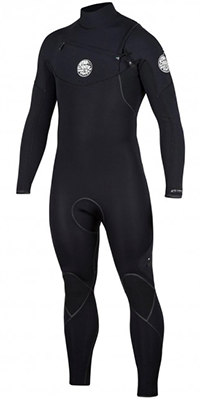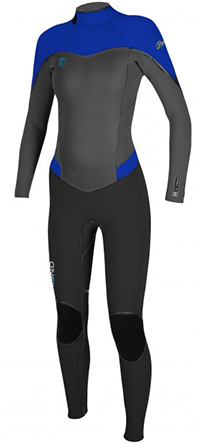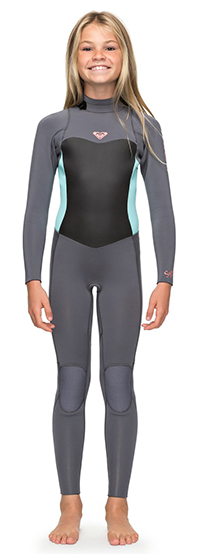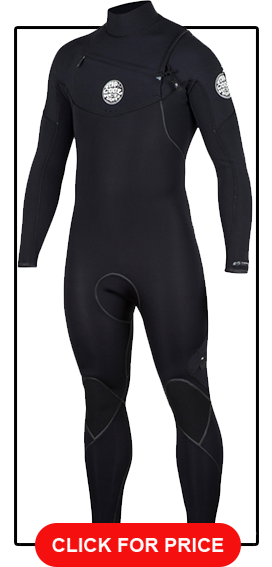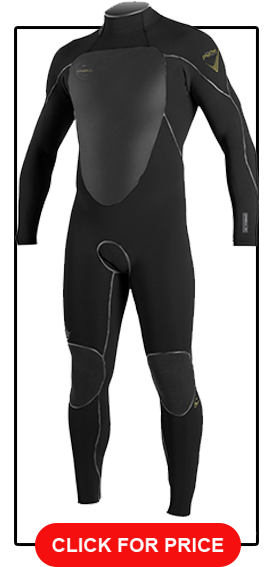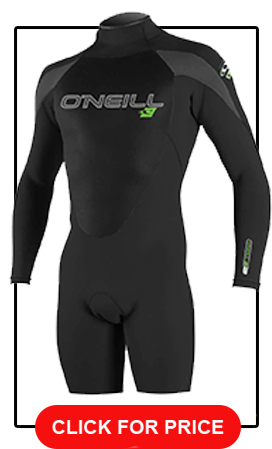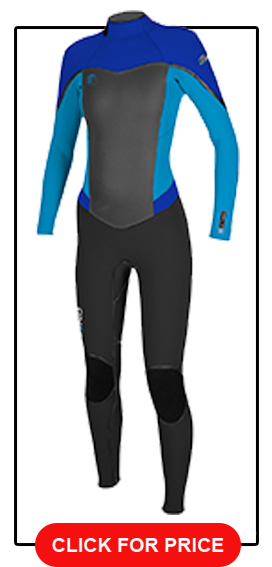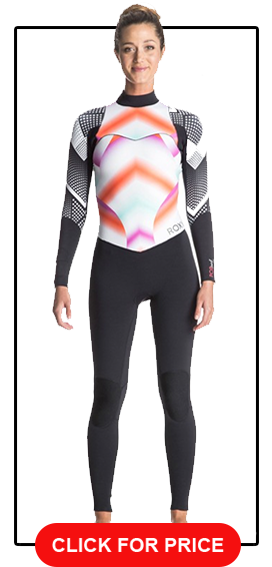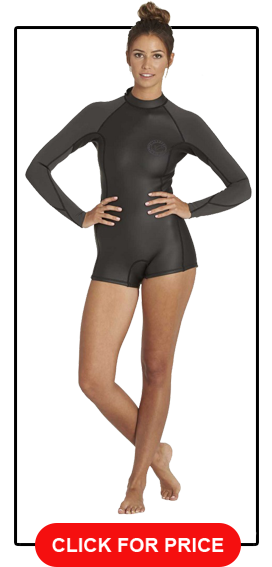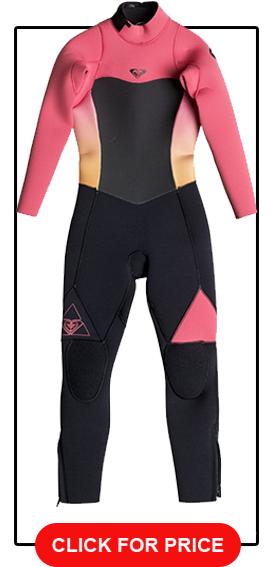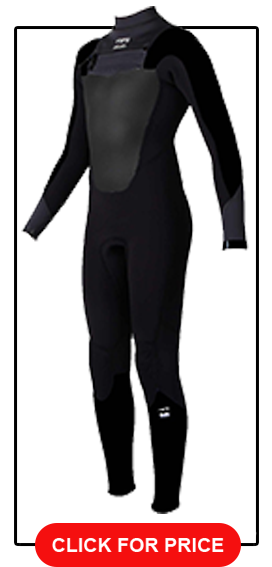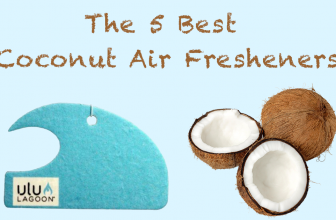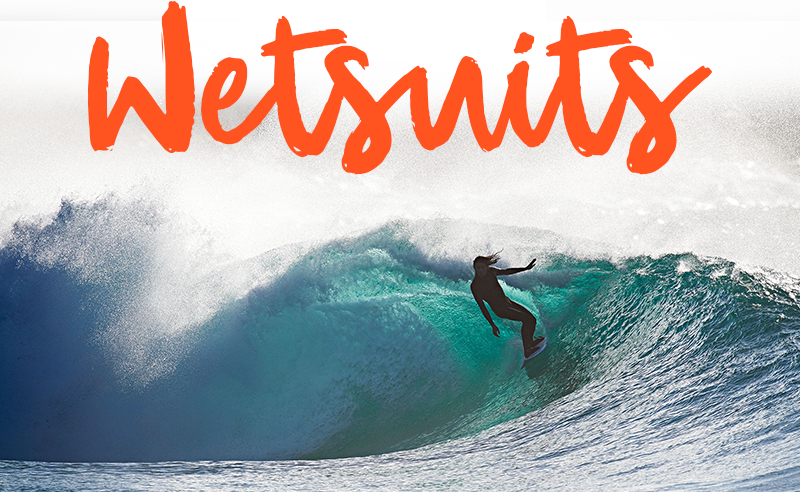
Having a superior wetsuit is one of the most essential factors in a great surf session.
The best surfing wetsuits are form fitting and help water lovers to stay in the ocean all year long...
More...
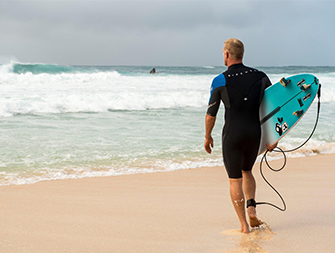
Choosing the right wetsuit can be difficult with all of the different guides on the Internet. You’ll want to make sure that you have the right thickness and length so you can stop worrying about the cold and start focusing on the fun.
Knowing how often you surf, what your price point is, and what water temperatures you’ll be paddling out in, are the utmost important components in making the right decision.
Before you even think about making a purchase, read our list of top wetsuits to get the best bang for your buck!
Our Favorite Wetsuits
- Made Out Of Warm and Toasty E4 Neoprene
- Lock Slide Chest Zipper
- Small Magnetic Pocket For Storing Goods
- TechnoButter Rapid Drying Air Insulation Neoprene
- SuperSeam Watertight No-Stitch Technology
- Abrasion Resistant Kneepads
- Best For Kids Ages 2-6!
- Warmflight Thermal Lining
- Hydrowrap Adjustable Neck Closure
The 3 Best Mens Wetsuits
Rip Curl E Bomb 4/3
The Rip Curl E Bomb 4/3 is one of the best mid-range wetsuits and gives surfers freedom and flexibility in a toasty, lightweight suit for cold waters.
The most standout feature is the E4 neoprene. This neoprene is a super comfortable material assuring natural movement so that you can paddle out without killing your energy, all while keeping warm.
The Rip Curl Lock Slide chest zipper makes for easy entry and the awesome part about the Hydro-loc Collar is that it seals around your neck to prevent flushing.
The Rip Curl E Bomb also uses a high quality GBS construction to help eliminate chafing.
With the small addition of the small magnetic pocket for storing goods, this is a wetsuit that you cannot go wrong with!
For more details and pricing info click on the "click for price" button or image!
O'Neill Psycho Freak Zen 3/2
As the evil twin of O’Neill’s Psycho One Z.E.N., the Psycho Freak Zen has been a huge favorite forever!
Though it’s one of the pricier suits, the Psycho Freak Zen holds it’s own in giving surfers the best features and technology available.
The Psycho Freak Zen uses a highly innovative TechnoButter Neoprene that is unique to the O’Neill company and known for its’ light performance and air insulation rapid drying performance.
The SuperSeam weld works to retain better warmth and makes for a very durable suit. Another awesome feature is the TechnoButter 2 AIR Firewall Neoprene in the chest and back panels.
This can help to absorb heat and keep you warm on the coldest of ocean days.
For the money, this suit packs all the necessary features for any avid surfer.
O’Neill Epic Springsuit
As the evil twin of O’Neill’s Psycho One Z.E.N., the Psycho Freak Zen has been a huge favorite forever!
Though it’s one of the pricier suits, the Psycho Freak Zen holds it’s own in giving surfers the best features and technology available.
The Psycho Freak Zen uses a highly innovative TechnoButter Neoprene that is unique to the O’Neill company and known for its’ light performance and air insulation rapid drying performance.
The SuperSeam weld works to retain better warmth and makes for a very durable suit.
Another awesome feature is the TechnoButter 2 AIR Firewall Neoprene in the chest and back panels.
This can help to absorb heat and keep you warm on the coldest of ocean days.
For the money, this suit packs all the necessary features for any avid surfer.
The 3 Best Women’s Wetsuits
O’Neill Flair ZEN 4/3
A huge seller for O’Neill’s women’s brand, the Flair Zen is very popular with female surfers!
The Flair is easily one of the best high-quality mid-range wetsuits on the market.
With TechnoButter rapid drying air insulation neoprene throughout the entire suit and double SuperSeam watertight no-stitch technology, this suit is perfect for enduring some of the gnarliest sessions.
We really dig the firewall on this suit, as it is one of the lightest available on the market.
By utilizing O’Neill’s patented Drainhole and Closure System, you can rest assured that you’ll be warm and dry at all times.
For those worried about saving those knees, this wetsuit comes with some very ergonomic and abrasion resistant kneepads to keep you in tip-top shape throughout your ride.
Roxy Pop Surf 3/2
Roxy’s Pop Surf suit is an excellent option for beginners as it is fairly cheap, yet still delivers in terms of flexibility and durability.
Roxy uses an FN light neoprene with air cells for a super, lightweight warmth.
Just like the Flair Zen, this suit comes with kneepads to help protect you from the harshness of your board.
The Back Zip entry system is a bit below standard, though still easy to get on and off.
For Roxy brand, this is surely one of their best suits on the market!
With a flaunt-worthy monochrome print design, you will be sure to catch some eyes in the water!
Billabong Surf Capsule Long Sleeve Springsuit
Our last pick for our women’s suits, The Billabong Surf Capsule Long Sleeve Springsuit is the perfect choice for any surfer looking for a lightweight suit during the warmer seasons.
From the moment you put it on, you’ll really dig the lightweight neoprene and wave-washed indigo prints that come together to make it so stylish and practical.
With a 90% neoprene and 10% nylon design, there’s a noticeable warmth for slightly windy days and quick-dry capability to allow for comfort after a session.
The logo screen on the chest is a sweet feature as well.
If you’re looking for a suit that is easy and super fashionable, this is the ideal one for you!
The 2 Best Kids Wetsuits
Roxy Girls Syncro 3/2
Roxy’s Syncro suit is easily one of the best on the market for girls. The suit is available for girls 2-6 at a very good price.
As like all of the newer Roxy suits, this one comes with an FN light neoprene, as well as a Thermal Smoothie neoprene.
Apart from being ultra flexible, this material acts as lightweight warmth and has a beautiful water resistant quality to keep the little ones warm.
Along with these two neoprene technologies, Roxy has added their Warmflight thermal lining to provide even more warmth and comfort.
The Hydroshield water barrier and Hydrowarp adjustable neck closure help in preventing water from getting into the suit.
We really love this suit and guarantee that your little one will not be disappointed!
Billabong Boys Absolute Comp
The Billabong Absolute Boys Comp is a killer wetsuit with all the high-end features and advanced construction techniques of any Billabong suit.
Featuring 100% AX2 Superflex neoprene for a 4 way stretch function, this suit allows the surfer to feel unrestricted at all times.
Another awesome feature is the glued and blind stitched seams for added warmth and comfort.
The Absolute Comp also comes equipped with Internal Hollow Fiber Thermal Lining that adds another layer of warmth, as well as super lightweight chest and back paneling with a wind resistant mesh.
This suit has been top choice in terms of boys’ suits for years. It’s perfect for surfing cold waters and has a longevity that will allow you to surf with it for a very long time.
If you want an affordable wetsuit from a reputable brand, this is definitely it!
Wetsuit Care
In this section we answer many wetsuit cleaning and care related questions, including:
How to clean and take care of a wetsuit
Wetsuits are great investments that can last for years of paddling out.
Though you may not think about it now, taking a short amount of time to clean your wetsuit after your session can be the difference between a suit that falls apart fast and one that grows old with you.
A proper rinse and dry rather than crumpling your salty suit up on the bathroom floor can keep it fresh and preserve the build. It only takes a small amount of effort to do so, and we’re going to tell you how!

1. Use a cold and complete fresh water rinse on the inside and out after every use. If you leave salt or sand on your suit can shorten the lifespan of it, as well as harden the neoprene, causing it to lose flexibility. When you do this, make sure to get the inside and outside.
If you begin to notice a nasty odor, whether from sweat, algae, chlorine, or anything else, just know that it is okay to wash your suit if you have a special wetsuit shampoo. Rip Curl Piss Off is an excellent shampoo choice!
2. When you get done washing, hang it up to dry. Make sure that the suit is turned inside out as this will help you avoid build up of mildew or any other odors that may arise from still water.
When hanging it, use a plastic hanger and hang it so that it folds in half near the waist.
You’ll want to be careful not to stretch the neck or shoulders by hanging it from there. Your best bet is to hang it indoors in your shower.
If that isn’t an option and you need to dry outside, make sure it is out of direct sunlight as this can damage the suit. Turn it back right side out and repeat the process.
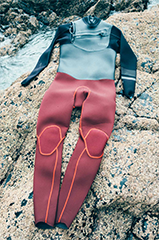
3. I always check for any damage in my suit when I get done washing and drying it. Any rips or tears mean that I need to take it into the shop for repair.
If you’re a DIY kind of person, you can use wetsuit cement to fix busted seams, or just stitch on a neoprene patch to the affected area. If you’re having a hard time getting those zippers up and down, a little beeswax can do the trick!
4. When the wetsuit is looking nice, fresh, and in tact, it’s ready to store. Again, make sure to never store it by hanging from the neck or shoulders! Also, never fold or crumple up into a drawer. Those are perfect ways to be left with a misshapen suit.
Either keep it hung up halfway over the hanger or lay it flat over a level surface. Try to keep your wetsuit in an environment with mild temperatures that is nice and dry to prolong its’ life.
Wetsuit Size Chart

How Should A Wetsuit Fit
Trying to slip into a wetsuit isn’t exactly the most enjoyable thing in the world.
Making sure to get a wetsuit that fits correctly can take some time and exploration and is much better than flailing around at the beach trying to get into one that doesn’t fit.
So obviously the question must be, how is a wetsuit supposed to fit?
If you end up getting a wetsuit that is too large, you are probably bound to experience flushing in the gaps that it leaves between the layers and your body.
If your suit is too tight, it can end up being a bit unbearable when you get in the water and can leave a strain on you when paddling out.
If you’re still feeling uncertain on how to get the proper wetsuit, we’ve created a little guide to make the process painless.
Size
The first thing you’ll want to know when putting on your wetsuit is that it must fit snugly. The point of a wetsuit is to stay close against your skin to help trap a layer of heat and water against your skin so that you stay warm. If it doesn’t have that snug quality, it totally defeats its purpose for insulation. Even though you want that snug fit, you still want to make sure that you’re able to move freely.
If the area around the neck feels too tight, it can put a lot of stress on your body in the water and make it more difficult to breathe. If you throw your wetsuit on and you feel a hunch in your posture, there’s a good chance it is to small. On the other hand, if there are big pockets of air and sagging material around your chest, crotch, and back area, it is too big.
Tips For Trying On Your Suit
- Once you put your suit on, bend and squat to make sure that you are not restricted in any way.
- Try and pull the suit away from your skin to make sure that there are no loose pockets of air keeping in mind that your wetsuit is a neoprene material that will loosen up when you hit the water.
Limbs
One you thing you don’t need to worry about too much when trying on your wetsuit is the length for the arms and legs. If they are a bit too short, no need to worry. It won’t have any effect on your swimming. If they are too long, it’s fairly easy to get them trimmed and sewn to make sure they are proper fitting.
Some people have longer legs and shorter torsos or vice versa. Most wetsuit manufacturers will include instructions on how to properly trim your suits if they are too long. It’s far more important that the torso area on your wetsuit is the right fit.
Collar
The collar on the other hand is a very important piece of your suit that you need to make sure is the proper fit right off the bat as you can’t trim or alter it without ruining the suit.
Just know that the collar will loosen and stretch the more you wear the suit, though if you have a big neck, it’s probably better to look at wetsuit brands that carry lower cut collars as they are typically larger as well.
It’s actually fairly often that we see surfers having to cut their sessions short, not because they are tired, but because the collar ends up making it more difficult for them to breathe.
Keep The Back Tight
It’s fairly often that we see swimmers wearing wetsuits that are loose fitting in the lower back region.
If it is loose down in this area, the wetsuit will have a large air pocket that will most likely fill with water while you’re out in the water.
Truly just make sure that this area on your wetsuit is snug so that you don’t have water flushing in and that you can breathe freely and comfortably.
Different Body Types
Many wetsuit companies will create size charts for purchasing a suit based on someone’s height and weight. The issue is that most of these companies don’t work for people with body types that aren’t typical.
If your shoulders or chest are very broad, you may want to go up a size. If you are very thin and tall, maybe consider going down a size. Different makes and models of wetsuit fit differently, so really take your time when trying them on.
Tricks To Get Your Wetsuit On Easily
Use A Plastic Bag
It may seem a bit weird, but a plastic bag can be very helpful in getting your wetsuit on quickly and easily. Simply put the plastic bag on your hand or foot and slide it into the wetsuit to guide your limb through. This helps so your skin doesn’t get stuck or snag on the neoprene when you’re trying to get it on.
Shampoo
Shampoo can actually be used as a lubricant to help get your limbs through. Before you get your suit on, mix a little shampoo with water and slather it on your arms and legs as you would lotion. With this little trick, not even the tightest of suits will be a match for you.
Wetsuit Color
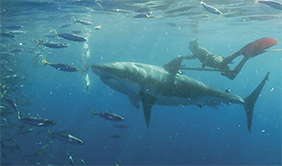
Why are most wetsuits we see black and not in color?
This is a question that has been answered and challenged by a million different people in a million different ways. Some say sharks have bad eyesight, and wearing black suits causes you to look more like a seal, AKA a tasty shark treat...
This is totally false, as most sharks that attack surfers see only in black and white, and are attracted to movement, not color.
Other note that colored suits would be better because black can attract more UV damaging rays. This is a possibility, but not a take all. For all we know, black is just the most ergonomic. It doesn’t fade as fast, neoprene comes in black, and they act better thermally...
The thing is, colored suits may actually have huge advantages that we’ve never seen until recently.
The colors that we wear can highly affect our self-perception and embodied cognition, making our physical and mental performance much better depending on the situation.
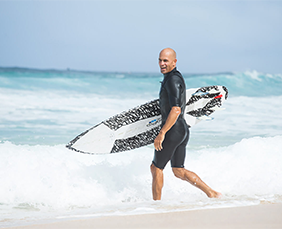
For example, a teacher who dresses in formal clothes is perceived as more intelligent than one who dresses casually, therefore perceiving his or herself as a more powerful figure.
This also goes hand in hand with a study conducted by Peter Dijkstra of the University of Glasglow and Paul Preenen of the University of Amsterdam who went into deep investigation of the claim that judo athletes in blue were far more likely to win than their competitors in white.
Though their investigation showed falsehood in the claim overall, they did take note that many colors had psychological effects.

They noted that red and orange has a very aggressive and dominant quality to it, impacting the individual’s mood, behavior, brain activity, and posture.
One study found that athletes in red have a winning bias over blue in a wide variety of contact sports.
Though many of these color associations may totally be true, throwing on a red wetsuit won’t make you the best surfer in the world, and wearing a black wetsuit won’t make you the dark figure athlete who is more likely to be called out for fouls and penalties according to quasi-experimental evidence from a dual university study back in 2011.
Your best bet is to find the color that makes you feel your best and remember that it could have a huge psychological effect turned physical effect on the way you surf.
The 8 New Wetsuit Technologies
1. Non-neoprene Rubber
As of 2016, Patagonia changed the world of surfing by creating a plant-based rubber.
Having this available gives surfers the chance to heavily reduce their carbon footprint and overall environmental impact.
This petroleum-based plant compound will largely reduce the necessary CO2 emissions to make neoprene rubber by around 80%.
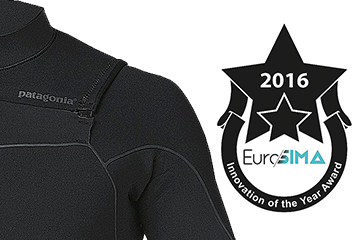
Patagonia product manager Hub Hubbard stated that “though neoprene, a quite nasty material, has been used for years, this is our first chance to try something completely alternative.”
As Patagonia continues to release their line of non-neoprene suits, as well as share this new technology with other companies, surfers can now be a part of the shift towards a more sustainable and eco-friendly approach to surfing.
2. Zipperless Neck

The zipperless neck technology was patented back in the 90s by Billabong.
Since then, it has evolved into a premium feature on many wetsuits that instead use strategically positioned paddle panels to create watertight seals.
Having a zipperless quality allows for insane flexibility, as for a long time, the long zippers killed any sort of flex in the area they were attached.
3. Scientific Interiors
Some wetsuit manufacturers are currently going above and beyond to make sure their suits are some of the warmest on the market without the usual bulk and build that unfortunately comes with cold water suits.
Exclusively with Xcel brand, their Thermo Dry Celliant is being showcased as the warmest wetsuit ever with clinically proven Smart Fiber Technology.
The material is an ultra responsive textile material that works with a surfer’s body heat to turn it into a renewable source of warmth. This is a one-of-a-kind material that is definitely changing the game.
O’Neill is also part of the quest for ultimate warmth and they are well ahead of the curve with their TechnoButter Air Firewall lining. It’s simple, more air held means more heat.
The complex 3D structure of the lining works like double glass and is 20% lighter and absorbs 30% less water than most of the leading neoprene linings.
It is the warmest, lightest, and fastest drying material that is currently on the market.
4. Faster Drying
Is there anything as irritating as nasty, damp and dank wetsuit after a cold morning session? I can’t think of anything quite as daunting when I’m really looking forward to paddling out.
Having a suit that dries super quickly is of utmost importance, and Rip Curl’s Flash Bomb and E Bomb wetsuits are front runners in the market for quick-drying wetsuit technology.
Most new suits are somewhat water resistant these days, but these guys have taken that idea to a whole new level so you never have to deal with that nasty feel again.
5. Seams: Higher Quality, Lower quantity
A suit that has forms well to your body and has a nice tight fit is achieved by having seams along separate tailored panels.
Because most seams aren’t too flexible, they’re typically kept away from areas where high flexibility is absolutely necessary.

More and more, companies are looking for ways to cut down on seams to introduce better flexibility, and many manufacturers such as Billabong, Quicksilver, Xcel, and more, have done so.
Companies that are constructing suits with new neoprene technologies allow suits to have the same tight fit without the use of a ton of seams.
These suits are great to keep an eye out for if you are in the market for ultimate flexibility.
6. Narrow & Flexible Liquid Seams
As you just read, and may have already known, seams are the number one thing that reduce solid flexibility in a good wetsuit.
Companies like O’Neill with their Double SuperSeam, or Xcel with their Fusion Weld Technology, are redefining the dreaded suit seam by making them far narrower, all while retaining a far better toughness and durability than suits with thicker seams.
If this technology continues to move forward, flexibility could advance to an all time high.
7. Shark Repellent
Though death by sharks is very rare, as it only accounts for 4 or 5 a year worldwide, the thought of a shark encounter has the ability to deter surfers from occupying certain spots at certain times.
A somewhat funky suit designed by an Australian company called SAMS for the colorblind shark, uses the optimum reflectance spectra that is difficult to spot in typical water conditions.
The suit uses similar principals to military camouflage. The tests for these suits haven’t completely solidified results, but even having peace of mind when surfing isn’t a horrible investment to make.
8. Animal Inspired... in the works

Small mammals such as beavers have a thick layer of fur that helps to trap warm air bubbles and protect them from harsh, cold-water conditions.
Luckily, a group of MIT engineers have banded together to create a rubber wetsuit that very much resembles that same layer of thick fur.
Looking at smaller mammals, rather than mammals such as whales, was key for this research, as the other main component of a wetsuit is flexibility, which creates agility.
So far, this is still a work in progress as the MIT team has yet to find a way to make the suits “furry” enough to actually trap air bubbles at those diving speeds, but given some time, this could be one of the coolest and most innovative technologies in the world of surf.
FAQ
Do Wetsuits Help You Float?
Actually, the wetsuit will help you float! Wetsuits are made of neoprene, which is a very buoyant material. They not only keep you warm, but also help you to float a bit more easily. This is definitely great for swimmers who are weaker as well.
Dry Suit Vs. Wetsuit
Wetsuits and Dry suits both have the same purpose in creating thermal insulation to protect from wind, water, or other weather related things that Mother Nature starts to throw at you. Though they are both designed to keep you warm, the main differences lie within the material and functionality.
Wetsuits are made from a rubber neoprene material and are made to keep you warm, not totally dry. They are best for surfers as they allow you be more athletic than if you were wearing a dry suit. Wetsuits are skin-tight and are better for water performance as they allow for greater speed and better maneuverability.
On the contrary, dry suits are made to be completely waterproof, though unlike wetsuits, they are not just for warmth. Dry suits act as a human carapace, resting on the wearer loosely, though keeping out all of the water. They certainly aren’t as sporty, though are worn a ton by divers, kayakers, and even SUP riders. If you don’t really mind the extra restrictiveness of a dry suits, then you might find their waterproof qualities very suitable.
Can I Dry My Wetsuit In The Dryer?
You should never, under any circumstances, put your wetsuit in a dryer. If you need to dry your wetsuit, just hang it up to air dry out of complete sunlight, as UV rays can ruin your neoprene.
What does Wetsuit Thickness Mean?
Wetsuits are measured in millimeters, the first number pertaining to the core, or abdomen part of the body, and the second number referring to the arms and legs. For example, if your wetsuit is a 4/3, that means the abdomen portion is 4mm thick and the arms and legs are 3mm thick.
Do wetsuits with titanium keep you warmer?
The claim that they give you almost double the warmth than most other wetsuits is an absolute lie that some companies use to try and sell their titanium infused wetsuits. There has never been any proven study to support this claim. A ton of companies use titanium in their neoprene without jacking up prices, as most marketers know that there is no added thermal retention in doing so.
What is the best way to put on a wetsuit?
- Slide your feet and legs through the leg holes and out to the other side so that the openings are above your ankles.
- Fold the top half inside out so that you can pull it from the inside and avoid tearing your wetsuit
- Pull it up both your legs so that it rides up on your crotch as much as possible. This will ensure that the panels and seams end up in their correct place and that there is no looseness.
- Roll the wetsuit up your torso and insert your arms one at a time using the one hand to push the other out the wrist holes. Make sure it is tight and snug under your armpits and above your shoulders.
- Pull everything up towards your neck to tighten it up, zip the back, and strap the neck if your suit calls for it
One wetsuit is too small, though the next available size is a bit too loose, which should I choose?
All wetsuits when first worn are going to feel tight, as they’ve never been wet before. Once you finally get them wet, the material will loosen and stretch out. Now, obviously you’ll want to make sure that you choose a wetsuit that feels most comfortable to you, but keep in mind that over time, wetsuits will stretch and grow to you, not the other way around.
What is the difference between a chest zip and a back zip?
A back zip is a more traditional style that uses a cord attached to a long zipper running down the back. These make for easy entry considering the tightness of some suits. The downside is, this leaves more area uncovered for water entry and many surfers feel that a back zipper restricts their flexibility a bit. A chest zip creates entry from the front, which may be slightly more difficult. The advantages include not having freezing water flush in and run down your back and the comfortability of not having a long zipper fixed down your back vertically.
Back Zipper Vs. Front Zipper Vs. No Zipper
Back Zipper
Pros
- Larger opening that can allow you to get in and out of your wetsuit more easily
- Back zipper wetsuits allow you to adjust the collar to get the right fit for your neck
- Better for bigger builds
Cons
- A back zipper can limit range of motion or be restrictive when swimming or paddling out
Front Zipper
Pros
- Having a zipper on the chest makes it easier to stretch and bend
- No restriction by from a zipper in the rear makes it much easier to paddle
Cons
- People with bigger builds might have a harder time getting in
No Zipper
Pros
- Does not leak as much without the extra zipper opening
Cons
- Much more difficult to get in and out of
Final Thoughts
Unfortunately, not everywhere is Hawaii. Having the right wetsuit can make or break a surfing session, and we hope you can find the one that is right for you!
Don’t forget to care for your suit as well, and keep on the lookout for the hottest new wetsuit technologies. Keep riding in that Endless Summer my surfing friends!

